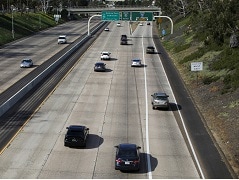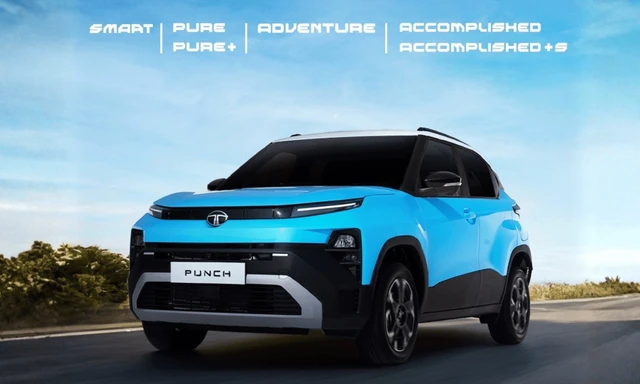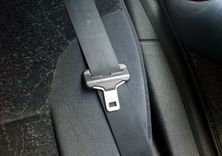Some Cars' Systems Designed To Keep Drivers' Eyes On The Road Fail - Study

Some vehicles equipped with automated assistance technology aimed at keeping drivers alert and watching the road fail at that job, an American Automobile Association study found on Tuesday. The AAA study said monitoring systems that rely only on how drivers' handle the steering wheel were not successful. Those that use cameras to monitor drivers' eye and head position were significantly more effective at keeping drivers focused while vehicle software is engaged.
On average, those direct monitoring systems issued an alert to the driver around 50 seconds sooner than those relying on indirect steering wheel input, AAA said. Monitoring systems are becoming widespread as part of advanced driver assistance systems (ADAS), which can automate some driving tasks and control a car's braking and acceleration. Automakers are offering them on more vehicle models and the cost of the technology boosts car sales prices.
Automakers tout the systems as improving safety and convenience, but insurance groups and safety researchers have repeatedly warned that drivers can mistake them for self-driving systems, leading to overreliance.

Tesla Model 3s and Ys produced in 2021 and later offer cabin cameras to determine driver inattentiveness, the carmaker says
The AAA study tested two camera-based monitoring systems, a 2021 Cadillac Escalade with General Motors' "Super Cruise" system and a 2021 Subaru Forester with "EyeSight" technology, and two systems that only rely on steering wheel engagement: a 2021 Hyundai Santa Fe with "Highway Driving Assist" and a 2020 Tesla Model 3 with "Autopilot."
The Hyundai system performed worst, followed by the Tesla. Subaru's and GM's systems were much better at keeping drivers engaged, but none of the monitoring systems performed perfectly. "Driver monitoring systems are a good first step to preventing deadly crashes, but they are not foolproof," said Greg Brannon, director of AAA's automotive engineering.
Tesla Model 3s and Ys produced in 2021 and later offer cabin cameras to determine driver inattentiveness, the carmaker says. AAA said it got a 2020 Model 3 strictly based on availability.
(This story has not been edited by NDTV staff and is auto-generated from a syndicated feed.)
Latest News
 Jaiveer Mehra | Jan 7, 2026Tata Harrier, Safari Petrol Launched In India: Prices Start From Rs 12.89 LakhBoth SUVs get the 1.5-litre Hyperion turbo-petrol engine from the Sierra in a higher state of tune.3 mins read
Jaiveer Mehra | Jan 7, 2026Tata Harrier, Safari Petrol Launched In India: Prices Start From Rs 12.89 LakhBoth SUVs get the 1.5-litre Hyperion turbo-petrol engine from the Sierra in a higher state of tune.3 mins read Carandbike Team | Jan 7, 2026Toyota Urban Cruiser EV India Debut On January 19Toyota’s entry EV is the sister model to the Maruti Suzuki e Vitara and shares the same underpinnings and tech.1 min read
Carandbike Team | Jan 7, 2026Toyota Urban Cruiser EV India Debut On January 19Toyota’s entry EV is the sister model to the Maruti Suzuki e Vitara and shares the same underpinnings and tech.1 min read car&bike Team | Jan 7, 2026Tata Punch Facelift Variants, Key Features RevealedThe Punch facelift will be offered in four familiar key trim levels and six variants.1 min read
car&bike Team | Jan 7, 2026Tata Punch Facelift Variants, Key Features RevealedThe Punch facelift will be offered in four familiar key trim levels and six variants.1 min read car&bike Team | Jan 7, 2026Skoda Kylaq Prices Hiked By Up To Rs 19,000Prices for the Kylaq subcompact SUV now start at Rs 7.59 lakh (ex-showroom).1 min read
car&bike Team | Jan 7, 2026Skoda Kylaq Prices Hiked By Up To Rs 19,000Prices for the Kylaq subcompact SUV now start at Rs 7.59 lakh (ex-showroom).1 min read Amaan Ahmed | Jan 7, 2026Ather 450X To Get Cruise Control; All 2025 Examples Will Receive Infinite Cruise Via OTA UpdateMore than 44,000 customers who bought the Ather 450X in 2025 will be eligible for the over-the-air update that will introduce 'Infinite Cruise'.1 min read
Amaan Ahmed | Jan 7, 2026Ather 450X To Get Cruise Control; All 2025 Examples Will Receive Infinite Cruise Via OTA UpdateMore than 44,000 customers who bought the Ather 450X in 2025 will be eligible for the over-the-air update that will introduce 'Infinite Cruise'.1 min read Jaiveer Mehra | Jan 7, 2026Afeela SUV Prototype Is Sony-Honda’s Next EVThe second model under the Sony-Honda joint venture to debut in production guise in 2028.1 min read
Jaiveer Mehra | Jan 7, 2026Afeela SUV Prototype Is Sony-Honda’s Next EVThe second model under the Sony-Honda joint venture to debut in production guise in 2028.1 min read
 Amaan Ahmed | Jan 3, 2026VLF Mobster 135 300 KM Review: Fun But FlawedA 125 cc scooter with Italian design and Chinese genes is a rare combination, and while some may be tempted to dismiss it because of its origins, the VLF Mobster shows 125s can also be exciting – but not without compromises.11 mins read
Amaan Ahmed | Jan 3, 2026VLF Mobster 135 300 KM Review: Fun But FlawedA 125 cc scooter with Italian design and Chinese genes is a rare combination, and while some may be tempted to dismiss it because of its origins, the VLF Mobster shows 125s can also be exciting – but not without compromises.11 mins read Preetam Bora | Dec 30, 2025TVS Orbiter Review: Real-World Performance and Range TestedThe TVS Orbiter is a promising electric scooter promising decent range, practicality and pricing. But is there any reason to avoid it? We spent a few days getting to know it better.9 mins read
Preetam Bora | Dec 30, 2025TVS Orbiter Review: Real-World Performance and Range TestedThe TVS Orbiter is a promising electric scooter promising decent range, practicality and pricing. But is there any reason to avoid it? We spent a few days getting to know it better.9 mins read Jafar Rizvi | Dec 24, 2025MG Windsor EV 38 kWh Long-Term Report: IntroductionThe Windsor EV has joined our garage, and before it settles into daily duty, I took it out to get a sense of what living with an electric car is like.4 mins read
Jafar Rizvi | Dec 24, 2025MG Windsor EV 38 kWh Long-Term Report: IntroductionThe Windsor EV has joined our garage, and before it settles into daily duty, I took it out to get a sense of what living with an electric car is like.4 mins read Seshan Vijayraghvan | Dec 23, 20252026 Kia Seltos Review: Formula Is Spot On, But Is The Timing Right?The 2nd-gen Kia Seltos has arrived, but it has the challenge of facing strong rivals like the Victoris and Sierra. The question is simple - Does it still have what it takes?9 mins read
Seshan Vijayraghvan | Dec 23, 20252026 Kia Seltos Review: Formula Is Spot On, But Is The Timing Right?The 2nd-gen Kia Seltos has arrived, but it has the challenge of facing strong rivals like the Victoris and Sierra. The question is simple - Does it still have what it takes?9 mins read car&bike Team | Dec 26, 2025Tata Punch EV Long-Term Second Report: Highway Performance, Pros & ConsAfter a week of living with the Tata Punch EV Long Range—including a proper Mumbai-Nashik highway test—we've learned what this little electric SUV is really made of.1 min read
car&bike Team | Dec 26, 2025Tata Punch EV Long-Term Second Report: Highway Performance, Pros & ConsAfter a week of living with the Tata Punch EV Long Range—including a proper Mumbai-Nashik highway test—we've learned what this little electric SUV is really made of.1 min read






















































































































